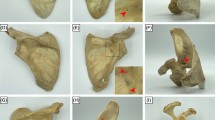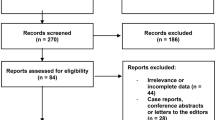Abstract
Purpose
The study was undertaken to make a qualitative and quantitative assessment of unnamed foramen and tunnels in adult human scapulae with aid of plain and contrast radiographs.
Materials and methods
A total of 120 dry bones, 60 each of the right and the left side were included in the study. Distribution of these foramina and tunnels was noted for their number, side, location, course and communication. Their morphometry was done using Vernier’s caliper.
Results
Incidence of scapular foramina was 7.5% (R > L), whereas scapular tunnels were seen in 15.8% cases. Incidence of the sinuous, curved, and straight tunnels was found to be 50, 39, and 10.7% respectively. Left-sided tunnels were longer than the right ones. Plain and contrast radiographs were taken to confirm the findings.
Conclusion
Anatomy literature describes only two scapular foramina, namely, nutrient foramen and suprascapular foramen/notch in a great zeal; occurrence of such anonymous foramina is hardly discussed. Through this study, there is an endeavor towards unfolding the mystery of scapular foramina in terms of their morphometry and distribution, the knowledge of which will aid clinicians, forensic experts, and surgeons in better diagnosis and management of clinical cases.




Similar content being viewed by others
References
Buntic R (2017) An atlas of microsurgery techniques and principles, Microsurgeon. Org Available via DIALOG. http://www.microsurgeon.org/scapulaflap
Burke RM (2005) Can we estimate stature from the scapula? A test considering sex and ancestry, May 2008. Available via DIALOG. http://etd.lsu.edu/docs/available/etd-04102008-155457/ unrestricted/ Burke_Thesis.pdf
Crankshaft Publishing (2017) Bone pathology and antemortem trauma in forensic cases what-when-how, In depth tutorials and information. Available via DIALOG: http://what-when-how.com/forensic-sciences/bone-pathology-and-antemortem-traumain-forensic-cases/
Cudi Tuncer M, Tacar O, Hatipoğlu ES (2005) Foramen scapulae osseum. Dicle Tıp Dergisi (Dicle Medical Journal) 32:40–42
Cunningham DJ (1918) Cunningham’s text book of anatomy, 5th edn. William Wood and Company, New York, pp 200–204
Dionisiadis E, Bismpa K (2006) An unusual case of langerhans cell histiocytosis (LCH). doi:10.1594/EURORAD/CASE.3300
Júnior JCG, Paccola AMF, Tonoli C, Zabeu JLA, Garcia JPM (2011) Arthroscopic release of the suprascapular nerve: surgical technique and evaluation of clinical cases. Rev Bras Ortop 46(4):403–407. doi:10.1590/S0102-36162011000400009
Gray DJ (1942) Variations in the human scapulae. Am J Phys Anthropol 29:57–72
Griffiths S (2015) The grim reality of life in ancient Egypt: Scarred skeletons reveal workers were brutally lashed with SPEARS if they were found stealing or slacking off at work, Mail Online. Available via Dialog: http://www.dailymail.co.uk/sciencetech/article- 3272664/The-grim-reality-life-ancient-Egypt-Scarred-skeletons-reveal-workers-brutallylashed-SPEARS-stealing-slacking-work.html
Gruber W (1871) Über ein congenitales Loch im unteren Schulterblattwinkel über dessen Epiphyse. Arch Anat Physiol Wissen Med 1871:300–304
Gruber W (1877) Zwei Scapulae mit je einem congenitalen Loche und eine Scapula mit einem congenitalen Fortsatze von zwei männlichen Skeletten. Arch Pathol Anat Physiol Klin Med 69:387–391
Hill MA (2017) Embryology musculoskeletal system—shoulder development. Retrieved January 21, 2017. Available via DIALOG: https://embryology.med.unsw.edu.au/embryology/index.php/Musculoskeletal_System_-_Shoulder_Development
Huang R1, Christ B, Patel K (2006) Regulation of scapula development. Anat Embryol (Berl) 211:65–71
Jason H Kim (2015) Scapular and parascapular free tissue transfer, otolaryngology and facial plastic surgery, drugs and diseases, medscape, updated: Aug 03, 2015. Available via DIALOG http://emedicine.medscape.com/article/881985-overview#showall
Mc Minn R M H (1990) Upper limb, last’s anatomy. Regional and applied, ELBS, 8th edn. Edinburg, United Kingdom, p. 74
Chabeuf M (1961) L’omoplate des Malgaches, Bulletins et Mémoires de la Société d’anthropologie de Paris Année. Numéro 3 2:351–359
Pate D, Kursunoglu S, Resnick D, Resnik CS (1985) Scapular foramina. Skeletal Radiol 14(4):270–275
Prescher A (2000) Anatomical basics, variations, and degenerative changes of the shoulder joint and shoulder girdle. Eur J Radiol Aug 35(2):88–102
Scheuer L, Black S (2004) The juvenile skeleton, Elsevier’s, Amsterdam, pp 252–261
Vallois HV (1926) Les anomalies de l'omoplate chez l'homme. Bull Soc Anthrop Paris 7:20–37
Williams MS (2003) Developmental anomalies of the scapula—the “omo”st forgotten bone. Am J Med Genet 120A:583–587. doi:10.1002/ajmg.a.20091
Author information
Authors and Affiliations
Corresponding author
Ethics declarations
Conflict of interest
The authors declare that they have no conflict of interest.
Rights and permissions
About this article
Cite this article
Singh, N., Chauhan, P., Loh, H.K. et al. Enigma of scapular foramen and tunnels: an untold story. Surg Radiol Anat 40, 327–332 (2018). https://doi.org/10.1007/s00276-017-1931-y
Received:
Accepted:
Published:
Issue Date:
DOI: https://doi.org/10.1007/s00276-017-1931-y




